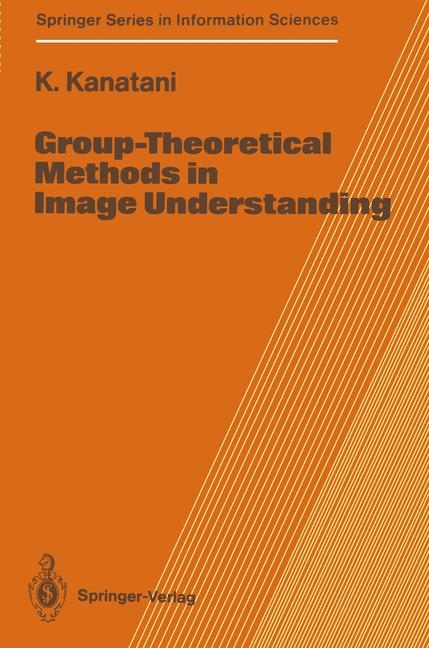
Group-Theoretical Methods in Image Understanding
Springer Berlin (Verlag)
978-3-642-64772-7 (ISBN)
- Titel ist leider vergriffen;
keine Neuauflage - Artikel merken
1. Introduction.- 1.1 What is Image Understanding?.- 1.2 Imaging Geometry of Perspective Projection.- 1.3 Geometry of Camera Rotation.- 1.3.1 Projective Transformation.- 1.4 The 3D Euclidean Approach.- 1.5 The 2D Non-Euclidean Approach.- 1.5.1 Relative Geometry and Absolute Geometry.- 1.6 Organization of This Book.- 2. Coordinate Rotation Invariance of Image Characteristics.- 2.1 Image Characteristics and 3D Recovery Equations.- 2.2 Parameter Changes and Representations.- 2.2.1 Rotation of the Coordinate System.- 2.3 Invariants and Weights.- 2.3.1 Signs of the Weights and Degeneracy.- 2.4 Representation of a Scalar and a Vector.- 2.4.1 Invariant Meaning of a Position.- 2.5 Representation of a Tensor.- 2.5.1 Parity.- 2.5.2 Weyl’s Theorem.- 2.6 Analysis of Optical Flow for a Planar Surface.- 2.6.1 Optical Flow.- 2.6.2 Translation Velocity, Rotation Velocity, and Egomotion.- 2.6.3 Equations in Terms of Invariants.- 2.7 Shape from Texture for Curved Surfaces.- 2.7.1 Curvatures of a Surface.- Exercises.- 3. 3D Rotation and Its Irreducible Representations.- 3.1 Invariance for the Camera Rotation Transformation.- 3.1.1 SO(3) Is Three Dimensional and Not Abelian.- 3.2 Infinitesimal Generators and Lie Algebra.- 3.3 Lie Algebra and Casimir Operator of the 3D Rotation Group.- 3.3.1 Infinitesimal Rotations Commute.- 3.3.2 Reciprocal Representations.- 3.3.3 Spinors.- 3.4 Representation of a Scalar and a Vector.- 3.5 Irreducible Reduction of a Tensor.- 3.5.1 Canonical Form of Infinitesimal Generators.- 3.5.2 Alibi vs Alias.- 3.6 Restriction of SO(3) to SO(2).- 3.6.1 Broken Symmetry.- 3.7 Transformation of Optical Flow.- 3.7.1 Invariant Decomposition of Optical Flow.- Exercises.- 4. Algebraic Invariance of Image Characteristics.- 4.1 Algebraic Invariants and Irreducibility.- 4.2 Scalars, Points, and Lines.- 4.3 Irreducible Decomposition of a Vector.- 4.4 Irreducible Decomposition of a Tensor.- 4.5 Invariants of Vectors.- 4.5.1 Interpretation of Invariants.- 4.6 Invariants of Points and Lines.- 4.6.1 Spherical Geometry.- 4.7 Invariants of Tensors.- 4.7.1 Symmetric Polynomials.- 4.7.2 Classical Theory of Invariants.- 4.8 Reconstruction of Camera Rotation.- Exercises.- 5. Characterization of Scenes and Images.- 5.1 Parametrization of Scenes and Images.- 5.2 Scenes, Images, and the Projection Operator.- 5.3 Invariant Subspaces of the Scene Space.- 5.3.1 Tensor Calculus.- 5.4 Spherical Harmonics.- 5.5 Tensor Expressions of Spherical Harmonics.- 5.6 Irreducibility of Spherical Harmonics.- 5.6.1 Laplace Spherical Harmonics.- 5.7 Camera Rotation Transformation of the Image Space.- 5.7.1 Parity of Scenes.- 5.8 Invariant Measure.- 5.8.1 First Fundamental Form.- 5.8.2 Fluid Dynamics Analogy.- 5.9 Transformation of Features.- 5.10 Invariant Characterization of a Shape.- 5.10.1 Invariance on the Image Sphere.- 5.10.2 Further Applications.- Exercises.- 6. Representation of 3D Rotations.- 6.1 Representation of Object Orientations.- 6.2 Rotation Matrix.- 6.2.1 The nD Rotation Group SO(n).- 6.3 Rotation Axis and Rotation Angle.- 6.4 Euler Angles.- 6.5 Cayley—Klein Parameters.- 6.6 Representation of SO(3) by SU(2).- 6.6.1 Spinors.- 6.7 Adjoint Representation of SU(2).- 6.7.1 Differential Representation.- 6.8 Quaternions.- 6.8.1 Quaternion Field.- 6.9 Topology of SO(3).- 6.9.1 Universal Covering Group.- 6.10 Invariant Measure of 3D Rotations.- Exercises.- 7. Shape from Motion.- 7.1 3D Recovery from Optical Flow for a Planar Surface.- 7.2 Flow Parameters and 3D Recovery Equations.- 7.2.1 Least Squares Method.- 7.3 Invariants of Optical Flow.- 7.4 Analytical Solution of the 3D Recovery Equations.- 7.5 Pseudo-orthographic Approximation.- 7.5.1 Robustness of Computation.- 7.6 Adjacency Condition of Optical Flow.- 7.7 3D Recovery of a Polyhedron.- 7.7.1 Noise Sensitivity of Computation.- 7.8 Motion Detection Without Correspondence.- 7.8.1 Stereo Without Correspondence.- Exercises.- 8. Shape from Angle.- 8.1 Rectangularity Hypothesis.- 8.2 Spatial Orientation of a Rectangular Corner.- 8.2.1 Corners with Two Right Angles.- 8.3 Interpretation of a Rectangular Polyhedron.- 8.3.1 Huffman—Clowes Edge Labeling.- 8.4 Standard Transformation of Corner Images.- 8.5 Vanishing Points and Vanishing Lines.- 8.5.1 Spherical Geometry and Projective Geometry.- Exercises.- 9. Shape from Texture.- 9.1 Shape from Texture from Homogeneity.- 9.2 Texture Density and Homogeneity.- 9.2.1 Distributions.- 9.3 Perspective Projection and the First Fundamental Form.- 9.4 Surface Shape Recovery from Texture.- 9.5 Recovery of Planar Surfaces.- 9.5.1 Error Due to Randomness of the Texture.- 9.6 Numerical Scheme of Planar Surface Recovery.- 9.6.1 Technical Aspects of Implementation.- 9.6.2 Newton Iterations.- Exercises.- 10. Shape from Surface.- 10.1 What Does 3D Shape Recovery Mean?.- 10.2 Constraints on a $$2/frac{1}
{2}/text{D}$$ Sketch.- 10.2.1 Singularity of the Incidence Structure.- 10.2.2 Integrability Condition.- 10.3 Optimization of a $$2/frac{1}{2}/text{D}$$ Sketch.- 10.3.1 Regularization.- 10.4 Optimization for Shape from Motion.- 10.5 Optimization of Rectangularity Heuristics.- 10.6 Optimization of Parallelism Heuristics.- 10.6.1 Parallelogram Test and Computational Geometry.- Exercises.- Appendix. Fundamentals of Group Theory.- A.1 Sets, Mappings, and Transformations.- A.2 Groups.- A.3 Linear Spaces.- A.4 Metric Spaces.- A.5 Linear Operators.- A.6 Group Representation.- A.7 Schur’s Lemma.- A.8 Topology, Manifolds, and Lie Groups.- A.9 Lie Algebras and Lie Groups.- A.10 Spherical Harmonics.
| Reihe/Serie | Springer Series in Information Sciences |
|---|---|
| Zusatzinfo | XII, 459 p. |
| Verlagsort | Berlin |
| Sprache | englisch |
| Maße | 155 x 235 mm |
| Gewicht | 714 g |
| Themenwelt | Naturwissenschaften ► Physik / Astronomie ► Allgemeines / Lexika |
| Schlagworte | computer vision • Differential Geometry • Geometry • Image Analysis • Image Processing • Image understanding • Invariant • Machine vision • Solution • Tensor • Topology |
| ISBN-10 | 3-642-64772-3 / 3642647723 |
| ISBN-13 | 978-3-642-64772-7 / 9783642647727 |
| Zustand | Neuware |
| Haben Sie eine Frage zum Produkt? |
aus dem Bereich


